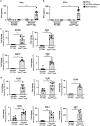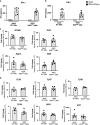Control of IFN-I responses by the aminopeptidase IRAP in neonatal C57BL/6 alveolar macrophages during RSV infection
- PMID: 33846534
- PMCID: PMC8221999
- DOI: 10.1038/s41385-021-00402-w
Control of IFN-I responses by the aminopeptidase IRAP in neonatal C57BL/6 alveolar macrophages during RSV infection
Abstract
Respiratory Syncytial Virus (RSV) is the major cause of lower respiratory tract infection in infants, in whom, the sensing of RSV by innate immune receptors and its regulation are still poorly described. However, the severe bronchiolitis following RSV infection in neonates has been associated with a defect in type I interferons (IFN-I) production, a cytokine produced mainly by alveolar macrophages (AMs) upon RSV infection in adults. In the present study, neonatal C57BL/6 AMs mobilized very weakly the IFN-I pathway upon RSV infection in vitro and failed to restrain virus replication. However, IFN-I productions by neonatal AMs were substantially increased by the deletion of Insulin-Responsive AminoPeptidase (IRAP), a protein previously involved in the regulation of IFN-I production by dendritic cells. Moreover, neonatal IRAPKO AMs showed a higher expression of IFN-stimulated genes than their wild-type C57BL/6 counterpart. Interestingly, depletion of IRAP did not affect adult AM responses. Finally, we demonstrated that newborn IRAPKO mice infected with RSV had more IFN-I in their lungs and eliminated the virus more efficiently than WT neonates. Taken together, early-life susceptibility to RSV infection may be related to an original age-dependent suppressive function of IRAP on the IFN-I driven-antiviral responses in neonatal AMs.
Conflict of interest statement
The author declares no competing interests.
Figures









Similar articles
-
Regulatory B Lymphocytes Colonize the Respiratory Tract of Neonatal Mice and Modulate Immune Responses of Alveolar Macrophages to RSV Infection in IL-10-Dependant Manner.Viruses. 2020 Jul 29;12(8):822. doi: 10.3390/v12080822. Viruses. 2020. PMID: 32751234 Free PMC article.
-
Alveolar Macrophages Can Control Respiratory Syncytial Virus Infection in the Absence of Type I Interferons.J Innate Immun. 2016;8(5):452-63. doi: 10.1159/000446824. Epub 2016 Jul 16. J Innate Immun. 2016. PMID: 27423203 Free PMC article.
-
Alveolar macrophages support interferon gamma-mediated viral clearance in RSV-infected neonatal mice.Respir Res. 2015 Oct 5;16:122. doi: 10.1186/s12931-015-0282-7. Respir Res. 2015. PMID: 26438053 Free PMC article.
-
Role of Type I Interferon (IFN) in the Respiratory Syncytial Virus (RSV) Immune Response and Disease Severity.Front Immunol. 2019 Mar 26;10:566. doi: 10.3389/fimmu.2019.00566. eCollection 2019. Front Immunol. 2019. PMID: 30972063 Free PMC article. Review.
-
How RSV Proteins Join Forces to Overcome the Host Innate Immune Response.Viruses. 2022 Feb 17;14(2):419. doi: 10.3390/v14020419. Viruses. 2022. PMID: 35216012 Free PMC article. Review.
Cited by
-
Severity of neonatal influenza infection is driven by type I interferon and oxidative stress.Mucosal Immunol. 2022 Jun;15(6):1309-1320. doi: 10.1038/s41385-022-00576-x. Epub 2022 Nov 9. Mucosal Immunol. 2022. PMID: 36352099 Free PMC article.
-
Sex- and time-dependent role of insulin regulated aminopeptidase in lipopolysaccharide-induced inflammation.Front Immunol. 2024 Oct 4;15:1466692. doi: 10.3389/fimmu.2024.1466692. eCollection 2024. Front Immunol. 2024. PMID: 39430768 Free PMC article.
-
Diverging patterns in innate immunity against respiratory viruses during a lifetime: lessons from the young and the old.Eur Respir Rev. 2024 Jun 12;33(172):230266. doi: 10.1183/16000617.0266-2023. Print 2024 Apr. Eur Respir Rev. 2024. PMID: 39009407 Free PMC article. Review.
References
-
- Smyth RL, Openshaw PJ. Bronchiolitis. Lancet. 2006;368:312–322. - PubMed
-
- Janssen R, et al. Genetic susceptibility to respiratory syncytial virus bronchiolitis is predominantly associated with innate immune genes. J. Infect. Dis. 2007;196:826–834. - PubMed
-
- de Kleer IM, et al. Perinatal activation of the interleukin-33 pathway promotes Type 2 immunity in the developing lung. Immunity. 2016;45:1285–1298. - PubMed
Publication types
MeSH terms
Substances
LinkOut - more resources
Full Text Sources
Other Literature Sources
Medical
Molecular Biology Databases
Research Materials

